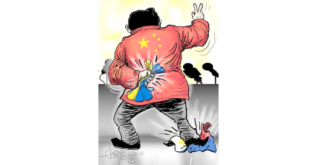The Coast Guard said the deployment of the buoys “highlights the Philippines’ unwavering resolve to protect its maritime borders and resources and contributes to the safety of maritime trade.”
 Not to be outdone, China announced days later that it, too, had put up buoys in three areas in the South China Sea “to ensure the safety of navigation and maritime operations.”
Not to be outdone, China announced days later that it, too, had put up buoys in three areas in the South China Sea “to ensure the safety of navigation and maritime operations.”
More than just being navigational aids and border markers, the Philippine buoys represent a new resolve by the Marcos government to assert control over the country’s maritime domains, as prescribed by international law.
The buoy deployments by the Philippines and China may have also opened another tense chapter in their long-running sea dispute. It is a conflict that has taken on a wider geopolitical scope.
In their recent summit in Hiroshima, the leaders of the G7 nations issued a communiqué that opposed Beijing’s militarization of the South China Sea, referring to its continuing effort to convert islets, atolls and reefs into heavily fortified encampments.
The G7 leaders said they “are determined to work together and with others to support a free and open Indo-Pacific and oppose any unilateral attempts to change the status quo by force or coercion.”
And in a tacit declaration of support for the Philippines in its dispute with China, they asserted there “is no legal basis for China’s expansive maritime claims in the South China Sea.”
“We reiterate that the award rendered by the arbitral tribunal on July 12, 2016 is a significant milestone, which is legally binding upon the parties to those proceedings and a useful basis for peacefully resolving disputes between the parties,” the G7 leaders said, without mentioning that it was the Philippines which contested China’s nine-dash-line argument before the tribunal.
Even before the G7 communique, the Philippines has received a flurry of affirmations of support from the United States, Japan and Australia in strengthening its security shield. The US has pledged to help accelerate the modernization of the Philippine military. More than that, it will be upgrading local bases where it will be allowed to rotate troop deployments and pre-position military equipment as a deterrent to attacks by foreign forces.
Japan is reportedly considering providing radar systems to the Philippines to help it monitor Chinese activity in the South China Sea.
Australia, on the other hand, will provide surveillance drones to the Philippine Coast Guard and is studying whether to take part in joint patrols in the disputed waterway.
Last week, the Philippine Navy announced that its two newly commissioned gunboats will patrol the West Philippine Sea as part of what President Ferdinand Marcos Jr. described as a shift “toward external defense of our borders.”
Buoyed by the reassurances from its allies, the President is confident that the Philippines is in a stronger position to face up to Beijing’s growing aggressiveness in asserting its territorial claims.
Avenues for negotiation
Since assuming the presidency last year, Mr. Marcos has been veering away from the fatalistic approach of his predecessor in engaging with China. Rodrigo Duterte had embraced the mantra that the Philippines doesn’t stand a chance in a war with China, so there’s no point putting up any resistance as it lays claim to all of the South China Sea.
Mr. Duterte all but ignored the Philippine victory in the arbitral court in The Hague. Mr. Marcos considers the victory as the legal linchpin that validates Philippine sovereignty over the West Philippine Sea.
At the same time, Marcos’ approach is flexible enough to leave avenues for negotiations open. “The seas that stretch before us are not to be seen as boundaries that divide our nations, but they must be seen as channels for mutually beneficial exchanges and collaboration,” he said.
For the time being, the Philippine and Chinese buoys have become part of an intricate chess game being played out in the South China Sea.
*****
Credit belongs to : www.manilatimes.net
 Atin Ito First Filipino Community Newspaper in Ontario
Atin Ito First Filipino Community Newspaper in Ontario






